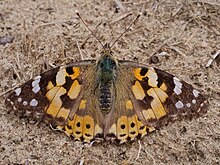Vanessa cardui
| Vanessa cardui | |
|---|---|
 |
|
| Upperside | |
 |
|
| Underside | |
| Scientific classification | |
| Kingdom: | Animalia |
| Phylum: | Arthropoda |
| Class: | Insecta |
| Order: | Lepidoptera |
| Family: | Nymphalidae |
| Genus: | Vanessa |
| Subgenus: | Cynthia |
| Species: | V. cardui |
| Binomial name | |
|
Vanessa cardui (Linnaeus, 1758) |
|
| Synonyms | |
|
Papilio cardui Linnaeus, 1758 |
|
| External identifiers for Vanessa cardui | |
|---|---|
| Encyclopedia of Life | 2682820 |
| ITIS | 188601 |
| NCBI | 171605 |
| Also found in: , ARKive, ADW, SDNHM | |
Papilio cardui Linnaeus, 1758
Vanessa cardui is a well-known colourful butterfly, known as the painted lady, or in North America as the cosmopolitan. This butterfly has a strange pattern of flying in a sort of screw shape.
dorsal side
ventral side
egg
larva
pupa
V. cardui is one of the most widespread of all butterflies, found on every continent except Antarctica and South America. In Australia, V. cardui has a limited range around Bunbury, Fremantle, and Rottnest Island. However, its close relative, the Australian painted lady (V. kershawi, sometimes considered a subspecies) ranges over half the continent. Other closely related species are the American painted lady (V. virginiensis) and the West Coast lady (V. annabella).
V. cardui occurs in any temperate zone, including mountains in the tropics. The species is resident only in warmer areas, but migrates in spring, and sometimes again in autumn. It migrates from North Africa and the Mediterranean to Britain in May and June, but for decades, naturalists have debated whether the offspring of these immigrants ever make a southwards return migration. Research suggests that British painted ladies do undertake an autumn migration, making a 9,000-mile round trip from tropical Africa to the Arctic Circle in a series of steps by up to six successive generations. The Radar Entomology Unit at Rothamsted Research provided evidence that autumn migrations take place at high altitude, which explains why these migrations are seldom witnessed.
V. cardui is known for its distinct migratory behavior. In California, they are usually seen flying from north to northwest. These migrations appear to be partially initiated by heavy winter rains in the desert where rainfall controls the growth of larval food plants. Painted lady migration patterns are highly erratic and they do not migrate every year. Some evidence suggests that global climatic events, such as el Niño, may affect the migratory behavior of the painted lady butterflies, causing large-scale migrations.
...
Wikipedia
